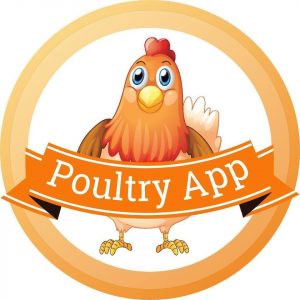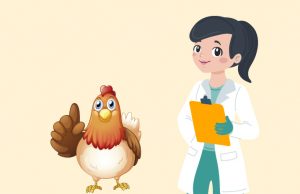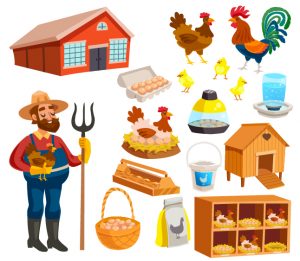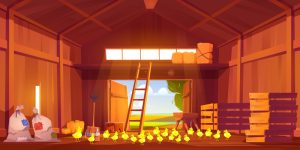
Feed Formulation
is a process of measuring the amounts of feed ingredients that require to be combined to make one uniform mixture (diet) for poultry that supplies all of their nutrient requirements. Since feed represents 65-75% of absolute live creation costs for a few kinds of poultry all over the world, a simple mistake in diet formulation is often extremely expensive for a poultry producer.
Feed formulation requires a thorough understanding of the:
- Nutrient requirements of the category in poultry (e.g., egg layers, & meat chickens)
- The limitation of nutrition processing and feed ingredients in terms of nutrients.
- Cost and availability of the ingredients.
Wide scope for poultry farmers to have their own nutritionists and feed plants, while little activities typically rely upon specialist nutritionists and business feed factories for their feeds. It is basic that details are accurate on the grounds that whenever takes care of are defined and made, it’s regularly past the point where it is possible to cure any errors or mistakes without bringing about critical costs.
Typical formulation
The poultry farmer should have knowledge on feed and poultry and as we know poultry is considered both art and science. A typical formulation shows the amounts of every ingredient that requires to be included within the diet, then provides the concentration of nutrients (composition) within the diet. The nutrient structure of the diet will indicate the acceptability of the diet for the actual class of poultry that it’s prepared.
It is common to means the energy value in metabolizable energy kcal or MJ ME/kg feed and protein content of the diet but comprehensive information on concentrations of mineral elements and digestible amino acids are also provided.
Chicken Feed ingredients:
With regards to food, I accept that beginning with the correct fixings has an enormous effect. Another method of putting it is, trash in/trash out. This is similarly applicable to chicken feed all things considered for developing vegetables or cooking.
Understanding what is in Chicken Feed will assist you in seeing all the various kinds of chicken feeds. The fundamental fixings in the chicken feed are oat grains, protein feast, fats oils, nutrients, and minerals. Every one of these fixings is combining to make a feed that meets the healthful necessities of chicken’s dependent on the age of the chicken (chick starter, pullet producer, laying hen) and purpose behind raising the poultry chicken (laying hen or meat chicken).
Layer feed and its ratios:
Layer chicken feed is formulated to meet the nutritional needs at a particular age of the chicken. Starter feed is kept to the chicken until they are six weeks old. The feed contains 16 percent to 18 percent protein. A broiler bird starter is not necessary for layer chicks.
Starter feed should contain about 18-20 percent cp and energy content up to 3000 Kcal/kg. Pullet should be fed up to 6 weeks. Chicken should be given access to the ground oyster shells, and the mix ratios differ according to the stage of the chicken.
Types of feed
Chick Feed:
Chick starter is fed for the first 6weeks to the baby chicks, it typically contains 22 percent to 24 percent of the protein for the meat birds’ layers feed consists of 20 percent of the protein.
Pullet for grower:
While the pullet grows the percentage of the protein can be diminished, with the reduction of the protein the pullet grows slow but it gains body weight and strong bones for laying eggs. Pullet growers will have up to 18 percent of the protein so that they might lay eggs too early.
Developer and finisher of pullet:
Protein is reduced to 16 percent once the chick reaches 14 weeks. Few of the feed lines do not mention the grower stage they give out grower-finisher which is somewhere in the middle protein-wise.
Forms of poultry feed:
Chicken and poultry feed comes in three structures: crumbles, pellets, and crush. crumbles are amazing in the event that you can get them, however, pellets are here and there the main structure accessible.
Crush is generally utilized for child chicks; however, it tends to be blended in with warm water to make a thick oat like a treat for chickens.
Mash:
Mash is a loose and unprocessed version of chicken feed; it is a texture of the potting soil. This feed is mostly used for the baby chicken as it is easy to digest.
The basic feed for the chicks is mash, it is mixed with some warm water to create liquid and to make sure that it is easily digested to the chicks.
The mash feed consists of soya bean, whole maze, wheat grams, wheat pollard, sunflower meal, linseed meal, benniseed meal or groundnut cake, fish meal, lime, salt, and premix, these are fed to the chicks by making powder.
Once the feed is mixed with the water it won’t last for a long time. The feed should consist of amino acids too, farmers can learn and add few more proteins if required.
Crumbles:
The crumble feed is rough feed like oats it is easier than mash, crumble feed does not have the same texture as a pellet. Few feeders like to feed crumble because it is a semi-loose variety.
The premix starts with barley, wheat, corn, peas, and oats, alfalfa pellets for the grind/whole portion, and cultured yeast, fish meal, kelp, flaxseed, crab meal, salt, and aragonite.
Few farmers prefer either mash or pellets but crumbles do help the growers. Here is the required grain material for premix. Most of the farmers make sure that they feed crumbles to the growers.
Pellets:
Pellets are fed to the grower-finisher. Pellets are known as common chicken feed which is very easily available in the market. Pellets have a long life once they are in the feeder. They are perhaps the foremost common sort of chicken feed available.
One of the benefits of using pellets is that they hold their shape nicely, which means they won’t go to waste if your birds accidentally knock their feeder over.
The pellet mix consists of flaxseed, crab meal, salt, aragonite, fish meal, cultured yeast, & corn, and there are few more options if the farmer wants to mix. Easy to manage, store, and serve, pellets often become the primary choice for many backyard chicken keepers.
Whole Grain Chicken Feed :
Whole-grain chicken feed is grains empty else mixed in. Some of the foremost common grains used for chicken feed are wheat, corn, barley, sorghum, and rye. Whole grains are not a complete feed.
- Chicken preference: Whole grains are often harder for baby chicks and growers (teenage chickens) to eat.
- Cost: Entire grains are minimal effort since they are not handled.
- Mess and waste: When one sort of whole grain is fed to the chicken, there will be no mess or waste.
- Health and wellness: There are advantages of entire grains and prepared grains.
- More nutritious: ground wheat loses supplements over the long run from rust.
- Improves processing: Entire grain kicks the stomach related issues energetically. The gizzard gets greater (which grinds food like a mechanical stomach) and stomach related cycles are energized in the small digestive system.
- Improves the immune system: Entire grains lose the pH level which prevents a few molecules from entering through the feed.
Chicken Scratch Feed
The chicken Scratch feed is a combination of various seeds and grains, for example, sunflower seeds, wheat, corn, and sorghum. Scratch feed consists of entire grains and seeds and they can be squeezed in the feed factory.
The size of the squeezed grain in scratch can fluctuate a great deal, from finely ground to a heavy blend.
Understand that scratch grains for chickens are certainly not a total feed. This implies it doesn’t give enough degrees of key supplements, for example, protein and calcium to keep your chickens healthy.
- Wreck and waste: Chickens will in general ruin scratch feed by utilizing their beak and feet to scratch through it and choose the grains and seeds they like (maybe this is the reason it’s called scratch).
- Cost: Scratch is simultaneously less expensive than pound and pellets since it’s made with next to no handling and has no protein and nutrients in it.
- Chicken inclination: Chickens like the wide range of seeds and grains in the scratch feed.
- Well-being and profitability: Scratch is anything but a total feed, which implies it doesn’t contain all the nutrients, minerals, amino acids, and levels of protein required in a chicken’s diet.
Important Tips on Feed Preparation:
- When making homemade feed, it is important to do trial preparation. Separate various chickens, feed them, and noticing their behavior and health. On the off chance that the feed portions are correct, the embryo develops quickly and the layers will expand egg creation (in any event 1 egg after at regular intervals).
- Should be cautious with the nature of feed fixings or crude materials. Poultry, particularly chickens are extremely touchy to takes care of that contain mycotoxins which are available in the vast majority of the crude materials. Never utilize spoiled maize to make chicken feed.
- Purchase quality fishmeal from organizations.
- It is imperative to blend all the micronutrients (amino acids) and premix first prior to blending in with the remainder of the feed.
- For blending, farmers are encouraged to utilize a drum blender (many welding craftsmen can make one). It won’t encourage utilizing a digging tool to blend feed on the grounds that the fixings might be uneven that might cause the feed to blend inappropriately. By utilizing a mechanical blender, the mixture becomes even.
- Never utilize spoiled fixings to make feed. Spoiled materials may contain mycotoxins which are hurtful to bird wellbeing.
These are the different types of feeds and their uses. With our poultry application, a fast and easy setup one can track his feedstocks, calculate feed formulation, and choose feed from leading feed suppliers.
We provide complete information on feed formulation and the exact amount of usage to feed for birds. You can save your precious time by updating your daily business accounts in minutes making it simple.
You can manage your entire business, feedstocks, and feed formulations in a single application.
These days mobile apps play a vital role in fuelling business growth, enhanced options in the poultry app do better in achieving your business goals and marketing.
Free of cost, we at poultry app are committed to ease of your poultry farming.
You can utilize our application for more technical guidance. To make the whole poultry farming experience much better, digitalized, and advanced download our app in the play store or app store.
Poultry App – Your True Digital Poultry Partner

Latest posts

Three common diseases in poultry farming

Smart techniques for better Poultry Farming& Management

Role& responsibility of the poultry farmer
